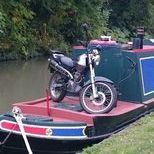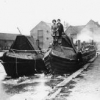-
Posts
3,415 -
Joined
-
Days Won
1
koukouvagia last won the day on December 29 2011
koukouvagia had the most liked content!
Contact Methods
-
Website URL
http://www.narrowboatowl.com and http://www.buttyhampton.com
Profile Information
-
Gender
Not Telling
-
Boat Name
1912 Braithwaite and Kirk motorised butty ex FMC
Recent Profile Visitors
15,681 profile views
koukouvagia's Achievements
-
As a purely temporary measure I stuck some of these furniture glide strips to the underside of my slide. Six years on they still work perfectly. The simplest solution is often the best. MUNSKT 20 Pieces Self-Adhesive Furniture Glides Teflon Rectangle circular Self-Adhesive Furniture Slides PTFE Self Adhesive Furniture Moving Slider for Carpet Hard Floor Wood Floors Furniture (Amazon)
-
Bran started following koukouvagia
-

Hydraulic drive for John Deere JD3
koukouvagia replied to Augustamay60's topic in Boat Building & Maintenance
That's precisely what the engineer had. He still couldn't explain the relief valve failure. Needless to say it worked perfectly when he tested it! The tests showed that after more than twenty years' use, the hydraulic pressure was exactly as it was when new. Some of the test equipment. -

Hydraulic drive for John Deere JD3
koukouvagia replied to Augustamay60's topic in Boat Building & Maintenance
Not always the case. I’ve had an ARS variable drive for over 25 years, giving excellent service. In all that time it the relief valve only once failed to operate; the resultant damage cost over £1500 to repair. An ARS trained engineer came to check the system but couldn’t find any reason for the failure. -
Mr Coggins, the Birmingham coal factor who was responsible for this invention, is seen leaning over the 4 cylinder 17 hp marine engine after a successful trial run from the Cannock Chase Colliery to Paddington in April 1917. I can't find exactly what engine was used, but a contemporary record states that petrol was used for starting and paraffin when running. It was claimed that the engine and attachments could be swapped from one boat to another in a few minutes.
-

A little bit more about Cones and narrowboats
koukouvagia replied to davidwheeler's topic in History & Heritage
Try this https://www.britishpathe.com/asset/188966/ Until I looked in detail at the drawings and watched this clip, I found it difficult to envisage the passage of water coming in at the narrow end of the cone and then being accelerated and ejected via the wider end of the cone. -

A little bit more about Cones and narrowboats
koukouvagia replied to davidwheeler's topic in History & Heritage
Fascinating. Are any of these amazing inventions still around - in museums, for example? A bit off topic, I admit. I came across this eccentric method of propelling canal boats. Needless to say, it never caught on. The article is from the Edinburgh Evening News, Aughst 1905. GAS-WORKED CANAL BOATS. On the Bridgewater Canal there was a trial yesterday of a new method of propelling barges. It is a very simple system, and if it realised the promoters hope it will work great change the traffic on canals. Colonel R Wilson Thom of Southport, has devised plan by which compressed coal gas may be used as the motive force and the chief recommendation of his invention is a reduction of the cost of propulsion by at least one half. As an example of what he proposes do, he has, with the sanction the Manchester Ship Canal Company, who control the Bridgewater Navigation, fitted up a 60-ton barge with a gas engine. This engine, with fittings, takes up very little space—only 6.5 feet—at the stern of the vessel. Gas is supplied at the high pressure of 200 lb. per square inch, and it may be as high 600lb. The gas is stored in twelve steel tubes, six on each side of the boat. Each tube is 15 feet length, the diameter of the bore being inches. Colonel Thom estimates that only cubic feet of gas will be needed to drive of 60 tons for one hour at a speed of 4 miles hour. The initial cost of the gas will be trifling, Another gain is as regards labour. Fewer will be required board. Then there is the advantage of cleanliness and the absence of unpleasant smells, such as accompany oil engines. A further gain is in the matter of weight, for 14 cwt represents the total weight of engine and machinery. A single charge of gas will suffice to work a loaded boat for twelve hours and to propel it fifty miles, with two other barges in its train. It is, intended form a company to bring the method of propulsion into use on our canals, in connection therewith to set up the necessary gas-producing plant at various centres. The by products of gas are expected to yield a considerable sum. The trial yesterday was quite successful. If the new method succeeds on canals, as it seems likely to do, one may look for its use other directions. -
That's exactly what I was looking for. Many thanks. PM sent.
-
Capella was fitted with the hydraulic drive in the ellum by WFBCo. Hampton was also fitted with the same system a few years later at WFBCo. The replica steel rudder was fabricated by Ken Freeman. I'd be very interested to see what Nebulae looked like below the water line. How much of the stern was cut away to accommodate the propeller? Did it have anti cavitation (ventilation) plates, I wonder?
-
As I understand it - and I may be wrong - Birdswood used to have a diesel engine driving an hydraulic motor built into the rudder, rather like Hampton. For environmental reasons the diesel engine had to be replaced by an electric motor. So it now has a unique electric/hydraulic sytem? I am hoping for some pictures of these motorised butties showing what they look like below the waterline.
-
I am putting the finishing touches to a book called Hampton, the story of a butty, which will be a companion to Owl, the story of a Josher. Hampton is motorised and I am looking for pictures of other motorised butties which show the various methods that have been used – e.g .with cut away back ends with swims, anti-cavitation plates, motors in the ellum, bolted on outboards etc. Obviously, I would need permission to use any image, which will be duly acknowledged. Many thanks for any help you can give. This is what we've done to Hampton with a hydraulic motor in the ellum. Has anyone successfully managed to put electric propulsion in a butty?
-

A to Z of Vintage Marine Engines by Kevin Whittle
koukouvagia replied to David Schweizer's topic in Vintage Engine Forum
-

A to Z of Vintage Marine Engines by Kevin Whittle
koukouvagia replied to David Schweizer's topic in Vintage Engine Forum
The late Kevin Whittle was a remarkable man. He was always keen to help and guide Kelvin owners like me and could usually find spare parts. He was also a one-man book publisher. He taught himself desk top publishing software and he designed and published his own books to a very high standard. An A to Z of Marine Engines and Vintage Marine Engines for Narrowboats and The Book of the Kelvin Model J are classics. He did this long before it before self-publishing became common. I would be very reluctant to sell my copies. Over many years he also single-handedly published a regular magazine, The Kelvin Register, which is full of articles and illustrations on the restoration and maintenance of Kelvins. This picture shows Kevin with a Kelvin engine which I discovered half buried in the Thames. Kevin had it transported to Shropshire andI believe it was brought back to life. I wonder what became of it? -
I must admit that this development is not bad, given that it was highly unlikely that a new use could be found for the former workshop once the wonderful old lock making machinery was taken out. What became of it? The manager's house must have lain derelict for over twenty years. I remember going to a public meeting which BW and the developers arranged. I recall someone saying that the old blacksmith's forge was a listed structure and would have to be incorporated into the new flats. I wonder if this ever happened.
-
It was a dark and stormy night in Limehouse (aka Bulbourne) . . There was quite a collection of historic boats for the filming which was supposed to be set in Limehouse. Owl, Hampton, Hood, Jaguar, Northolt and Holland were called upon to add background verisimilitude.
-
We used to take our two boats up from Cowroast to Bulbourne for the Open Weekends. I suggest that the good publicity for the canals from that event achieved far more than the blue signs and wellness campaigns. We would show local school children around our boats and at the weekend they would return with their parents.













.thumb.jpg.9d9fdba8add6d15e88a41df54accc3f8.jpg)
.thumb.jpg.8c13e66b32f53d817be37883dff3a7ef.jpg)

